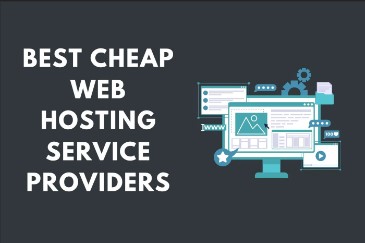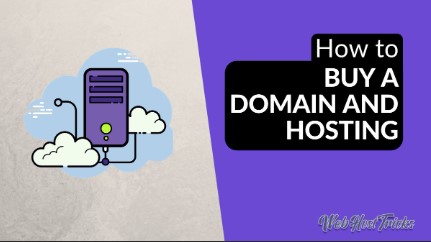Domain Purchase And Web Hosting
In the dynamic realm of establishing an online presence, the journey begins with the acquisition of a domain name and the selection of a web hosting service.
Let’s explore the intricacies of domain purchase and web hosting, unraveling the process step by step to empower you to launch your online venture with confidence and clarity.
Understanding Domains
What is a Domain Name?
At its core, a domain name serves as the digital address of a website, akin to the street address of a physical location. It’s the alphanumeric string that users type into their browsers to access a specific website. The importance of domain names cannot be overstated; they serve as the gateway to your online presence, embodying your brand, identity, and purpose in a succinct and memorable format.
Definition and Importance
A domain name comprises two main components: the actual name chosen by the website owner and the domain extension, also known as the top-level domain (TLD). The domain name reflects your brand identity and facilitates user recognition and recall, while the TLD denotes the purpose or geographic location of the website (.com, .org, .net, etc.). Choosing the right domain name is crucial for establishing brand consistency, credibility, and visibility in the digital landscape.
Anatomy of a Domain Name
A domain name follows a hierarchical structure, consisting of multiple levels separated by dots. For example, in the domain name “www.example.com,” “www” is the subdomain, “example” is the second-level domain (SLD), and “.com” is the top-level domain (TLD). Each level serves a specific purpose in directing web traffic and organizing online resources, contributing to the overall functionality and accessibility of the website.
Types of Domain Extensions
Domain extensions, also known as TLDs, encompass a diverse range of options tailored to different industries, geographic regions, and purposes. Understanding the nuances of domain extensions is essential for selecting the most suitable option for your website and target audience.
Generic Top-Level Domains (gTLDs)
Generic TLDs such as .com, .org, and .net are among the most widely recognized and utilized domain extensions. They are versatile and applicable to various types of websites, making them popular choices for businesses, organizations, and individuals seeking a global online presence.
Country Code Top-Level Domains (ccTLDs)
Country code TLDs are specific to individual countries or territories, denoting their geographic location or affiliation. Examples include .us for the United States, .uk for the United Kingdom, and .de for Germany. Country code TLDs are ideal for businesses targeting local markets or seeking to establish a presence in specific regions.
New Generic Top-Level Domains (TLDs)
New generic TLDs are a recent addition to the domain name landscape, offering a diverse array of options beyond traditional gTLDs and ccTLDs.
These include industry-specific TLDs such as .tech, .store, and .blog, as well as branded TLDs like .apple, .google, and .amazon. TLDs provide unique opportunities for branding, marketing, and niche targeting, enabling businesses to differentiate themselves and enhance their online visibility.
Selecting the Perfect Domain Name
Factors to Consider
Choosing the perfect domain name requires careful consideration of various factors to ensure alignment with your brand identity, objectives, and target audience. From brand consistency and memorability to keyword relevance and SEO impact, every aspect plays a crucial role in shaping the effectiveness and success of your online presence.
Brand Consistency and Memorability
A domain name should resonate with your brand identity and values, reflecting the essence of your business or organization in a concise and memorable format. It should be easy to spell, pronounce, and remember, facilitating user recognition and recall across various channels and touchpoints.
Keyword Relevance and SEO Impact
Incorporating relevant keywords into your domain name can enhance its visibility and search engine rankings, making it easier for users to find and access your website. However, it’s essential to strike a balance between keyword optimization and brand identity, ensuring that the domain name remains relevant, authentic, and memorable to your target audience.
Domain Availability and Registration Options
Before finalizing your domain name choice, conducting availability checks and research is imperative to ensure that the desired domain is available for registration. Domain availability can vary depending on factors such as popularity, competition, and existing trademarks.
Additionally, exploring registration options and pricing plans offered by different domain registrars can help you make informed decisions and secure the best deal for your needs and budget.
Tips and Strategies
Embarking on the quest for the perfect domain name may seem daunting, but with the right tips and strategies, you can streamline the process and uncover hidden gems that align with your brand vision and objectives.
Brainstorming Creative Domain Ideas
Gather your team or brainstorm solo to generate a list of potential domain name ideas, exploring different themes, concepts, and keywords relevant to your industry, niche, or target audience. Encourage creativity, experimentation, and out-of-the-box thinking to uncover unique and memorable domain options that stand out in a crowded digital landscape.
Utilizing Domain Name Generators
Harness the power of domain name generators to automate the brainstorming process and generate a wide range of domain name suggestions based on your input criteria. Domain name generators utilize algorithms and databases to generate available domain options tailored to your preferences, saving time and effort while expanding your domain name repertoire.
Conducting Availability Checks and Research
Once you’ve compiled a list of potential domain name candidates, conduct availability checks and research to assess their availability, suitability, and viability for your online venture. Utilize domain registration platforms and WHOIS databases to verify domain availability, ownership status, and historical data, enabling you to make informed decisions and avoid potential conflicts or infringements.
Registering Your Domain
Choosing a Domain Registrar
With your ideal domain name in hand, the next step is to choose a domain registrar to facilitate the registration process. Domain registrars are accredited entities authorized to register and manage domain names on behalf of domain owners, offering a range of services and features to support your online endeavors.
Factors to Consider
When selecting a domain registrar, several factors should be taken into account to ensure a seamless and secure registration experience. From reputation and reliability to pricing and customer support, each aspect plays a crucial role in determining the quality and effectiveness of the registrar’s services.
Popular Domain Registrar Options
Numerous domain registrars operate in the market, each offering unique features, pricing plans, and service levels to cater to diverse customer needs and preferences. Exploring popular domain registrar options can help you compare offerings, assess reputations, and ultimately select the registrar that best aligns with your requirements and objectives.
Domain Registration Process
Once you’ve chosen a domain registrar, the domain registration process typically involves several steps to complete the necessary paperwork, provide relevant information, and secure ownership of your chosen domain name.
Step-by-Step Guide
Follow this step-by-step guide to navigate the domain registration process smoothly and efficiently:
1. Create an Account: Register for an account with your chosen domain registrar, providing basic contact information and creating login credentials for future access.
2. Search for Your Domain: Utilize the registrar’s domain search tool to check the availability of your desired domain name and explore alternative options if necessary.
3. Select Your Domain: Once you’ve found an available domain name that meets your criteria, add it to your cart and proceed to the checkout stage to initiate the registration process.
4. Complete Registration Forms: Fill out the required registration forms with accurate and up-to-date information, including your name, address, email, and payment details.
5. Choose Registration Options: Review and select additional registration options such as domain privacy protection, which shields your personal information from public WHOIS databases and helps prevent spam and identity theft.
6. Confirm and Submit: Double-check your registration details for accuracy and completeness before submitting your order. Once confirmed, proceed to payment and submit your registration request to the registrar.
Domain Privacy Protection Options
Domain privacy protection, also known as WHOIS privacy or domain privacy protection service (DPMS), is an optional add-on offered by domain registrars to safeguard the personal information of domain owners from public view.
Understanding Web Hosting
What is Web Hosting?
In simple terms, web hosting refers to the process of storing website files, data, and content on a server connected to the internet, making it accessible to users worldwide. Web hosting services provide the infrastructure and resources necessary to host websites, ensuring their availability, reliability, and performance.
Definition and Importance
Web hosting plays a critical role in the functionality and accessibility of websites, serving as the foundation for online presence and interaction. Without web hosting, websites would be inaccessible to users, rendering them invisible and ineffective in the digital landscape. Choosing the right web hosting service is essential for ensuring optimal performance, security, and scalability of your website.
Types of Web Hosting Services
Web hosting services come in various forms, each catering to different needs, requirements, and budgets. Understanding the differences between these hosting types is crucial for selecting the most suitable option for your website and online objectives.
Shared Hosting
Shared hosting is a popular and cost-effective hosting solution where multiple websites share resources and server space on the same server. While shared hosting is budget-friendly and easy to manage, it may suffer from performance limitations and resource contention due to shared server resources.
Pros and Cons
Shared hosting offers several advantages, including affordability, simplicity, and ease of setup. However, it may also have limitations in terms of performance, scalability, and security, making it less suitable for high-traffic or resource-intensive websites.
Ideal for Small to Medium Websites
Shared hosting is ideal for small to medium-sized websites with moderate traffic and resource requirements. It provides a cost-effective and beginner-friendly hosting solution for individuals, startups, and small businesses looking to establish an online presence without breaking the bank.
VPS Hosting
Virtual Private Server (VPS) hosting offers a more advanced and flexible hosting solution that combines the benefits of shared hosting and dedicated hosting. In a VPS environment, multiple virtual servers are created on a single physical server, each operating independently with dedicated resources and isolation from other virtual servers.
Pros and Cons
VPS hosting offers greater control, customization, and scalability compared to shared hosting, allowing users to allocate resources and configure server settings according to their specific needs.
However, it may require more technical expertise and management than shared hosting, making it better suited for experienced users or businesses with growing resource demands.
Ideal for Scalability and Control
VPS hosting is ideal for websites that require greater scalability, performance, and control than shared hosting can provide. It offers a scalable and customizable hosting solution that can adapt to changing resource requirements and accommodate future growth without sacrificing performance or stability.
Dedicated Hosting
Dedicated hosting provides the highest level of performance, reliability, and security by allocating an entire physical server exclusively to a single website or client.
Unlike shared hosting or VPS hosting, dedicated hosting offers full control over server resources and configurations, enabling users to optimize performance and security according to their specific requirements.
Pros and Cons
Dedicated hosting offers unparalleled performance, security, and customization options compared to other hosting types. However, it also comes with higher costs, technical complexity, and maintenance responsibilities, making it more suitable for large enterprises, high-traffic websites, and mission-critical applications.
Ideal for High-Traffic Websites and E-commerce
Dedicated hosting is ideal for websites with high traffic volumes, resource-intensive applications, or stringent security requirements. It provides the ultimate in performance, reliability, and security, ensuring optimal user experience and data protection for demanding online ventures.
Selecting the Right Web Hosting Provider
Factors to Consider
Choosing the right web hosting provider is a critical decision that can impact the performance, security, and success of your website. With numerous options available in the market, evaluating key factors is essential for making informed decisions and selecting a provider that meets your needs and objectives.
Performance and Reliability
Performance and reliability are paramount considerations when selecting a web hosting provider. A reliable hosting provider should offer robust infrastructure, high uptime guarantees, and fast server response times to ensure optimal performance and availability for your website.
Scalability and Resource Allocation
Scalability and resource allocation are essential factors for accommodating growth and fluctuations in website traffic and resource demands. A scalable hosting solution should offer flexible resource allocation, upgrade options, and scalability features to support your website’s evolving needs over time.
Security and Support
Security and support are critical aspects of web hosting that should not be overlooked. A reputable hosting provider should offer robust security measures, including firewalls, malware scanning, and SSL encryption, to protect your website and data from cyber threats and vulnerabilities.
Additionally, responsive customer support and technical assistance are essential for resolving issues promptly and ensuring a smooth hosting experience.
Evaluating Hosting Plans
Once you’ve identified your hosting requirements and priorities, evaluating hosting plans from different providers can help you compare features, pricing, and value-added services to find the best fit for your website and budget.
Shared Hosting Plans
Shared hosting plans typically offer basic features, limited resources, and affordable pricing suited for small to medium-sized websites with moderate traffic and resource requirements.
They are an ideal entry-level hosting solution for individuals, bloggers, and small businesses looking to establish an online presence without investing in dedicated resources.
VPS Hosting Plans
VPS hosting plans offer greater flexibility, performance, and control compared to shared hosting, making them suitable for websites with higher traffic volumes, resource-intensive applications, or specific customization requirements.
VPS hosting plans vary in terms of resource allocation, scalability options, and management levels, allowing users to choose the plan that best aligns with their needs and technical expertise.
Dedicated Hosting Plans
Dedicated hosting plans provide the highest level of performance, reliability, and security by allocating an entire physical server exclusively to a single website or client.
Dedicated hosting plans offer full control over server resources and configurations, making them ideal for high-traffic websites, e-commerce stores, and mission-critical applications that require maximum performance and security.
Purchasing Web Hosting and Setting Up Your Website
Choosing a Hosting Plan
After evaluating hosting plans and selecting a provider that meets your requirements, the next step is to choose a hosting plan that aligns with your budget, performance, and scalability needs.
Assessing Resource Requirements
Consider factors such as website traffic, storage space, bandwidth, and processing power when assessing your resource requirements and selecting a hosting plan. Choose a plan that offers sufficient resources to accommodate your current needs and allows room for future growth and scalability.
Comparing Features and Pricing
Compare the features, pricing, and value-added services offered by different hosting plans to find the best fit for your website and budget. Look for plans that offer essential features such as unlimited bandwidth, SSD storage, free domain registration, and SSL certificates,





